Dr. Bill's MN Geology Snapshots
Dr. Bill Cordua is an Emeritus Professor of Geology and an Honorary member of the MMC who writes brief, fun and informative "snapshots" about Minnesota Geology.
Iron Formation
What’s this – an alien planet? No, it’s a view (about 7 mm across) through the microscope of some iron formation, in a slab sawn coated with mineral oil. The multicolored clots and pellets are mostly made of hematite and quartz – variety jasper. They are likely dismembered microbial deposits that accumulated in a shallow sea about 2 billion years ago, when the iron formation was being deposited. Sample from the glacial drift of the St. Croix Valley.
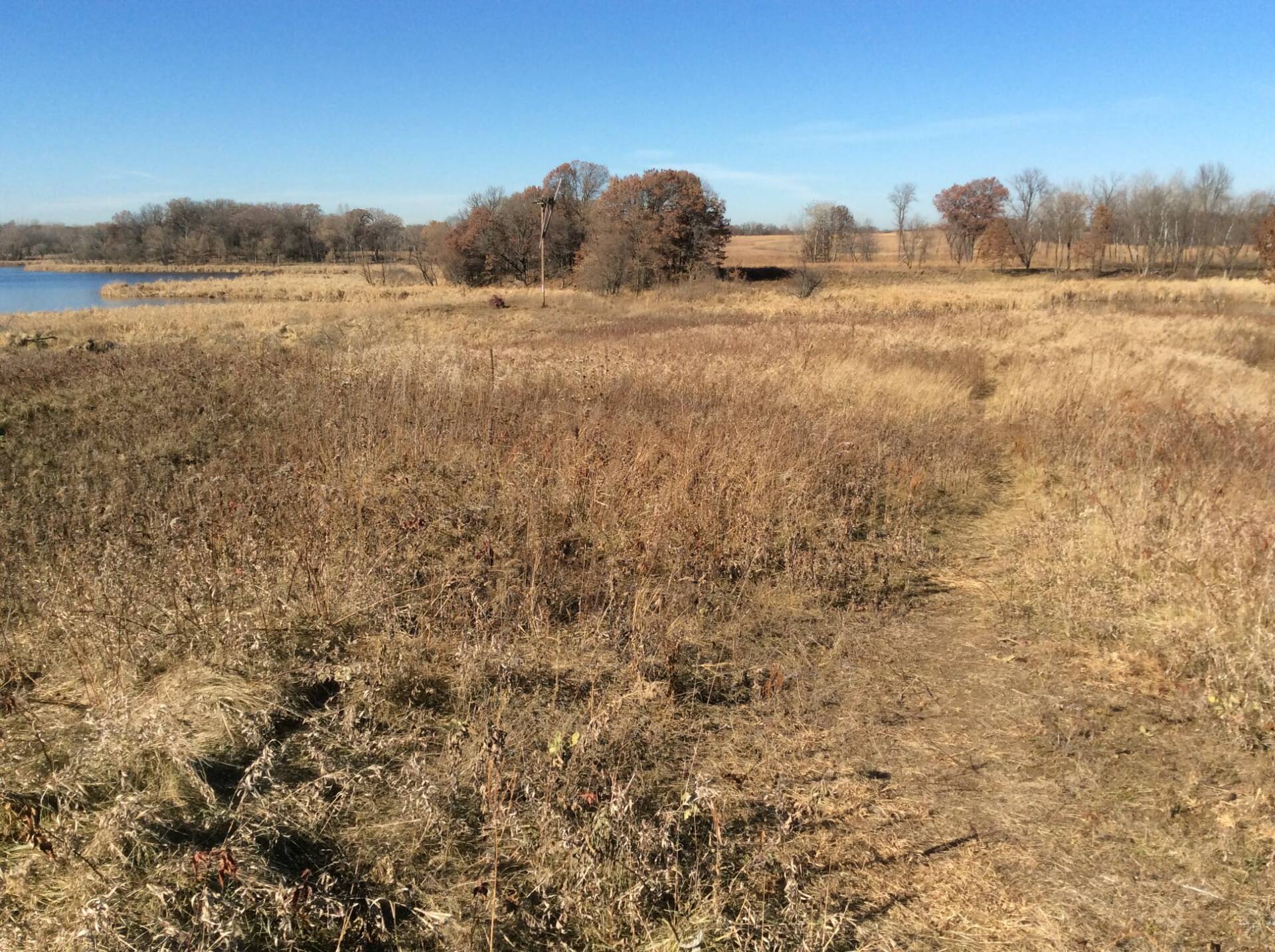
Cromwell Formation
Landscape in Lake Elmo Regional Preserve, Washington County, Minnesota. This is underlain by the Cromwell Formation, which is sediment deposited by the Superior Lobe glacier between 13,000 and 33,000 years ago. The rolling terrain is the result of stagnant ice, left behind when the glaciers retreated. As the ice melted, sediment on top of and within the ice was left behind as hummocky hills and depressions.

Xenoliths
Xenoliths (“stranger stones”) are chunks of rocks picked by a magma on its way to the surface. When the magma solidifies, the xenoliths are trapped liked raisins in raisin bread. Here is a white granitic magma with xenoliths of dark amphibolite. This specimen is from the 2.7 billion year old igneous body called the Giants Range Batholith, collected near Biwabik, St. Louis County, Minnesota.

Calcite
Calcite is fun but common mineral with many diverse habits. This is some cave travertine uncovered in a quarry near Red Wing, MN. The calcite crystals formed little stacked triangular pyramids. This calcite also fluoresces and phosphoresces blue under short wave and long wave UV light.
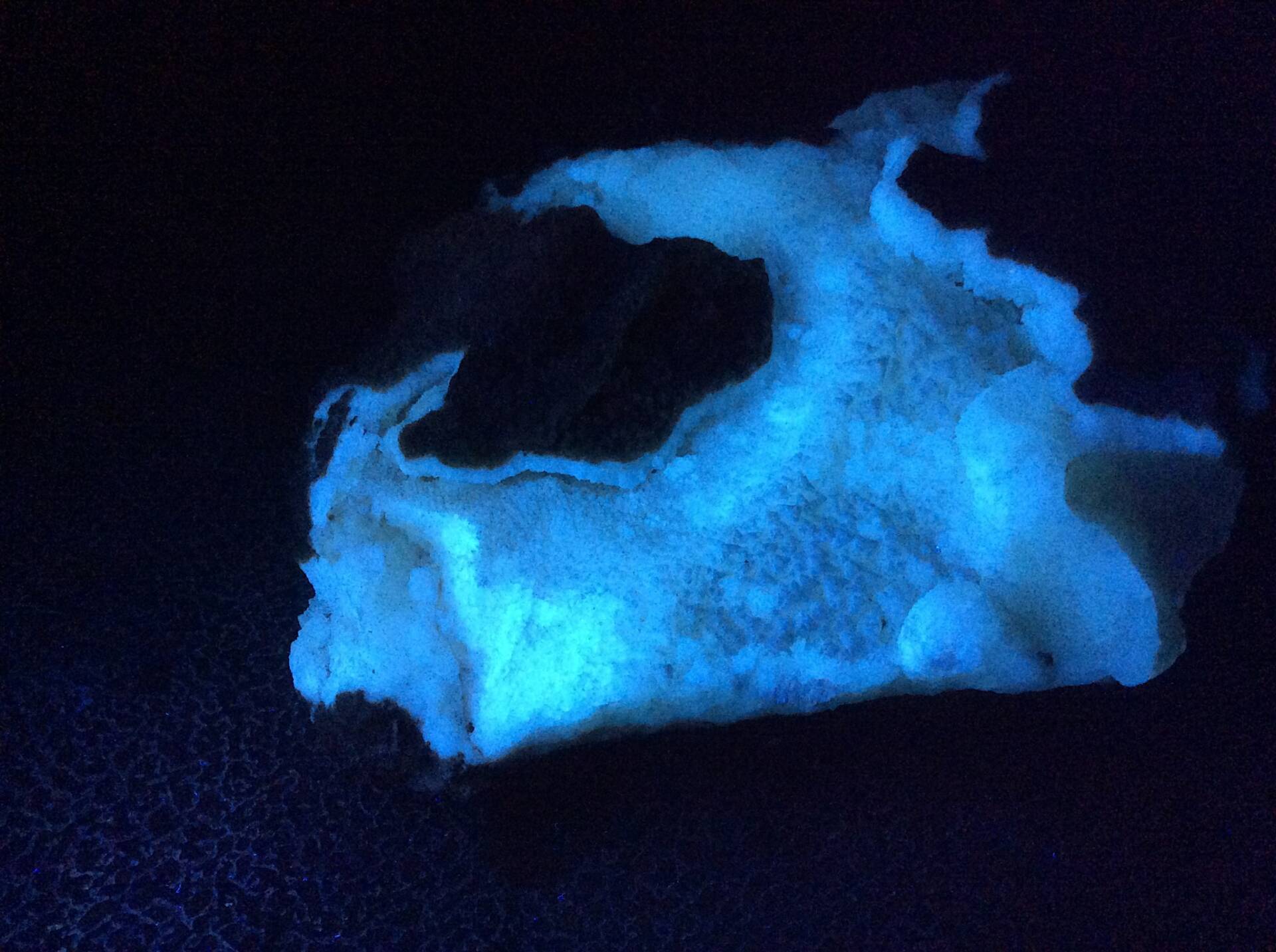
Calcite Under UV Light
Here is the same calcite specimen viewed in short wave UV light.
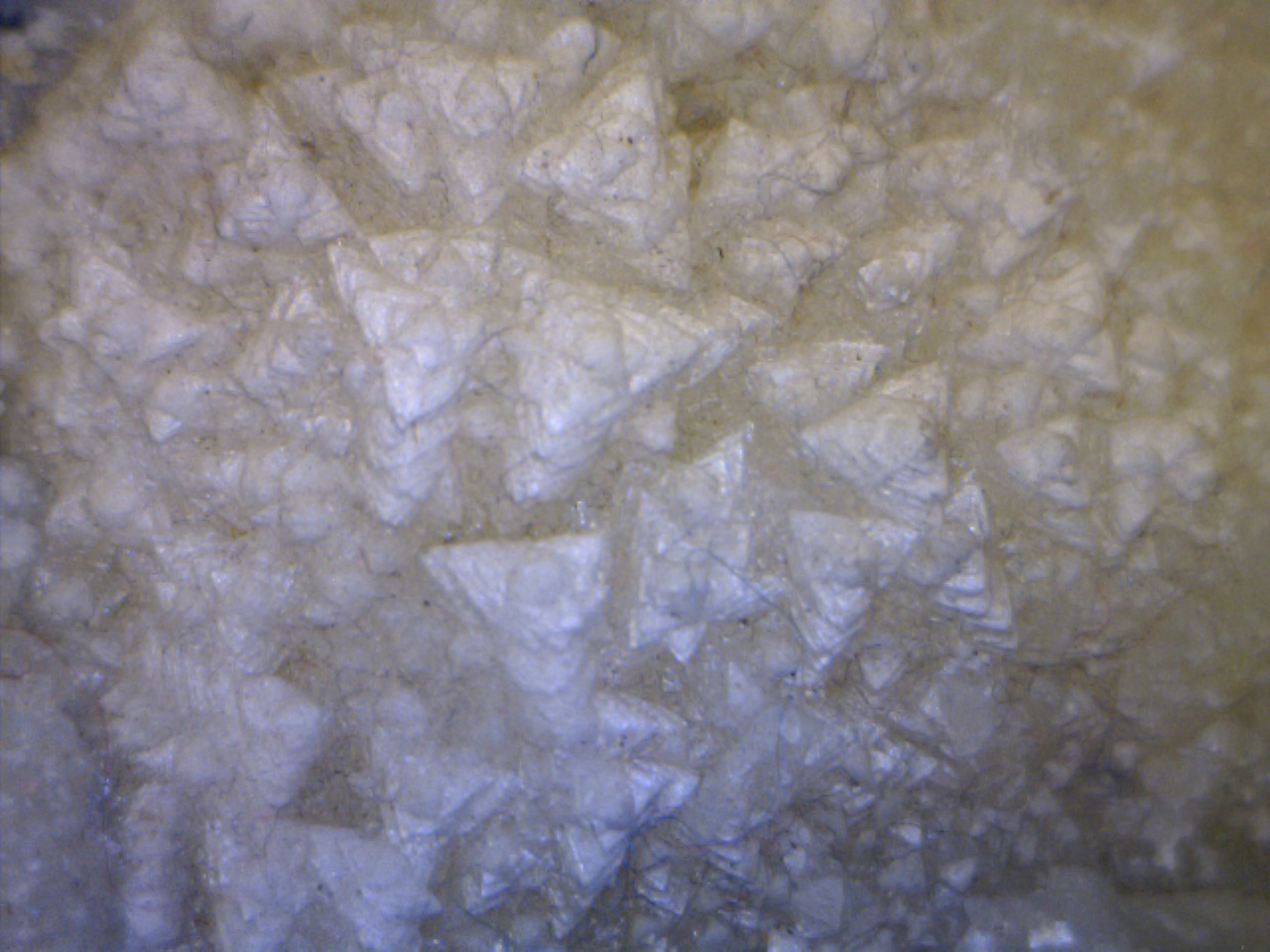
Calcite Pyramids
And while we are on this specimen, here is a close-up of the little stacked pyramids of calcite.

Granite Fault Surface
Landscape block of white granite (in Woodbury, MN) showing a fault surface. The surface is coated with red hematite from water seeping along the fault. The lines going nearly parallel to the hammer handle and arrow are called slickensides. They are little striations that formed when the two sides of the fault slide passed each other. The fault movement was parallel to the lines. The little “stair steps“ parallel to the top of the hammer tells us the upper fault block (now gone) moved right to left, as indicated by the arrow.
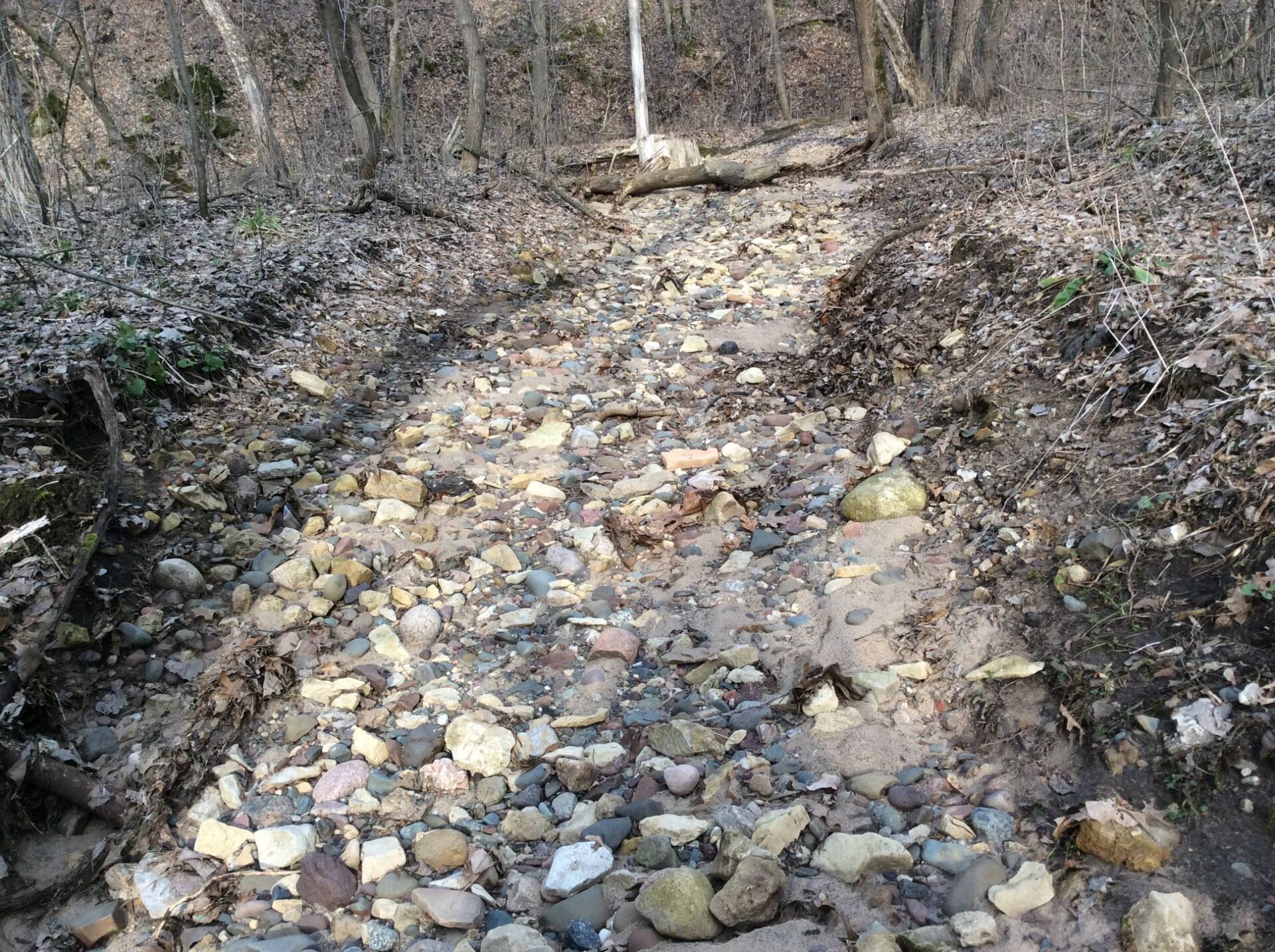
Dry Runs
Dry runs are great places to look for rocks. This one drains an area with dolostone bedrock covered by glacial outwash. The light angular cobbles are dolostone. Other common rocks coming from the glacial sediments are dark basalt and gabbro, lighter colored granites, jasper, quartzite and rhyolite. An agate or two, maybe? Great place to build a basic rock collection.

Stromatolite
Stromatolite in place in its dolomite bedrock. These are cabbage-like mounds built by photosynthesizing cyanobacteria on the shallow sea floor. They are common in certain horizons of the Ordovician Prairie du Chien Group rocks (about 480 million years old) exposed in outcrop, quarry and road cut along the Mississippi River Valley below Hastings.

Feldspar
Purple plagioclase feldspar, from road cut near Ilgen City, MN. This calcium-rich feldspar can be identified by the rule-straight lines (striations) that go along many of the flat cleavage surfaces (arrow). Plagioclase in the road cut makes up most of an igneous rock called anorthosite, which was carried up as large chunks by magma that intruded the abundant lava flows of the region.

Banded Iron Formation
“Ribbon Rock” or “Rainbow Rock” boulder on the shore of Isle of Pines in Knife Lake, BWCA. Photo by Allen J. Moe, used with his kind permission. The rock is as glacial erratic of banded iron formation (BIF). This rock is interlayered white quartz, red jasper and black iron oxides. It has been folded at numerous times during its long history. The earliest folding may have been from slumping when it was soft sediment. Later folding was due to mountain building forces.
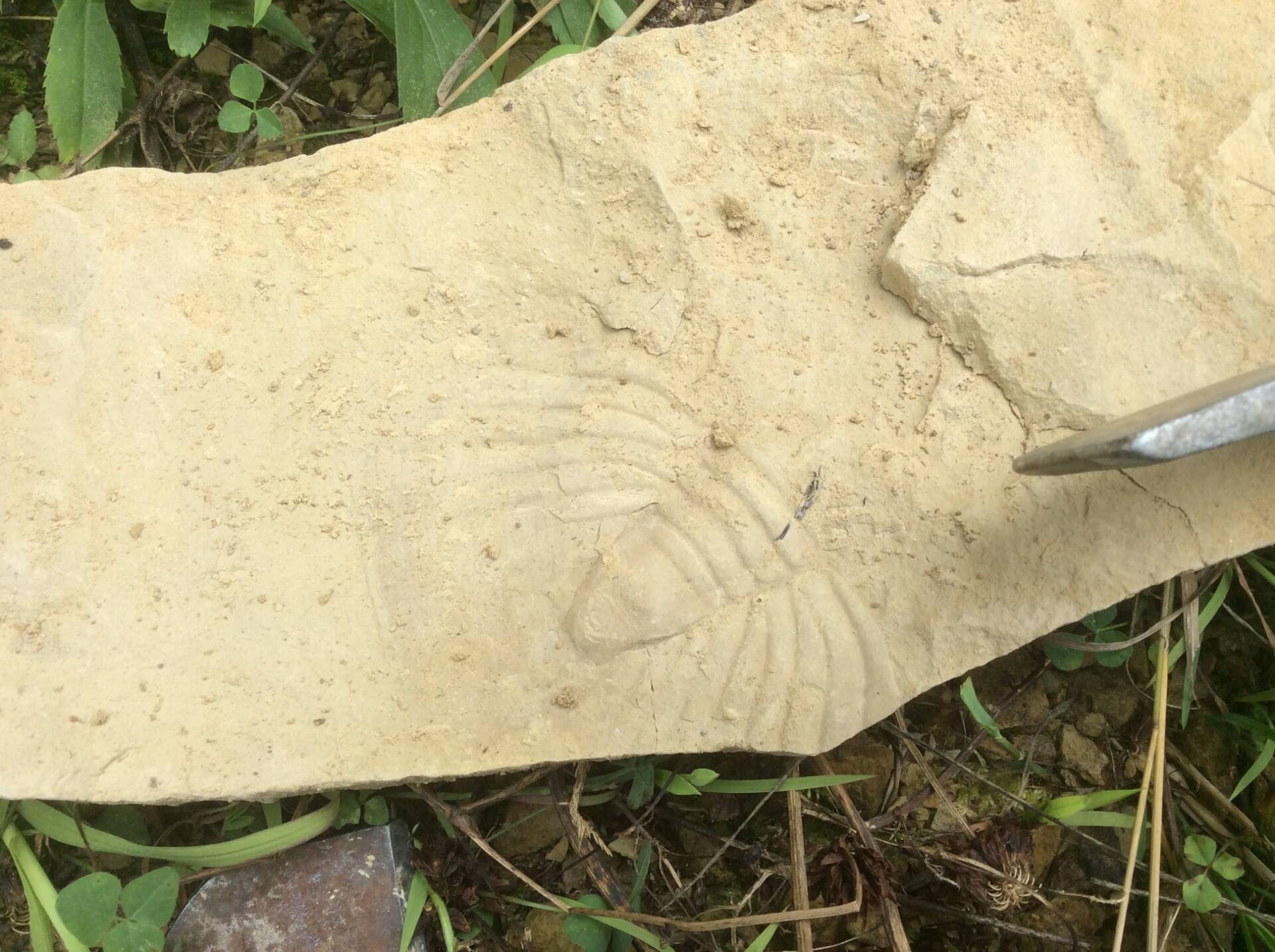
Dikelocephalus Trilobite
Dikelocephalus trilobite – impression of tail (pygidium) in silty dolostone. Chisel end of a rock hammer for scale. These were very large trilobites that lived during the late Cambrian. Collected from the St. Lawrence Formation from a road cut near Theilman, Wabasha County, Minnesota.

Groutite
Groutite (manganese hydroxide) crystals on hematite matrix (sample about 5 cm or 2 inches across) from the Robert Mine, Cuyuna Iron Range, Crow Wing County, Minnesota. The mineral was first described on samples from Minnesota and is named for U. of Minnesota geology professor Dr. Frank Grout.

Granitic Intrusive Complex
Contact between two granite masses in the St. Cloud granitic intrusive complex, seen near Rockville, Sherburne County, MN. The granitic rocks intruded over a 50 million year stretch between 1,780 and 1,730 million years ago. The gray granitic rock on the left (technically a granodiorite not a true granite) intruded first and cooled. The pink granite on the right came later, the magma chilling against the now cool gray granodiorite, forming the fine-grained pink boundary. The green lichen on the outcrop formed, of course, last.

Sandstone
Ripple marks in sandstone of the Cambrian Franconia Formation, exposed in a roadcut on Highway 61 , near Whitman, Winona County, Minnesota. These were formed by currents flowing across the shallow sea floor when this was soft sediment.

Meteorite
Sawn fragment of the Fisher Minnesota Meteorite. The sample is about 2 cm. across. This stony meteorite was seen to fall, with loud rumblings and explosions, on April 9, 1894, near the town of Fisher, Polk County, Minnesota. Residents found fragments of it collectively massing 17.6 kgs (39 pounds) . Note the scattered iron-nickel alloy masses. The matrix is mostly altered olivine and pyroxene.

Fossil
Ornate round fossils common in the limestone of the Decorah Formation are parts of crinoids stems. Crinoids, or “sea lilies” looked like plants growing on the sea floor, but were really animals. They had a cuplike top with fronds, rising on a stalk and strained passing plankton out of sea water. When the crinoid died, the stalk segments fell apart, giving us these Cheerios-like sections. This sample, about 7 mm across, was collected from a road cut near Hader, Goodhue County, Minnesota.

Thomson Formation
Syncline (down fold) in the 2 billion year old Thomson Formation exposed along the St. Louis River, in Jay Cooke State Park, south of Duluth. The Thomson Formation is made of interlayered slates and “dirty” sandstones (greywackes). The slates were clay-rich sediment accumulating slowly in deep water while the sands were deposited by fast-moving turbidity currents flushing sediment in from shallower water. The syncline was folding due to a mountain-building episode called the Penokean Orogeny.

Gabbro
Close up (about 2 cm across) of a cut slab of gabbro, a common rock in Minnesota, moistened with mineral oil. The green is where light- colored plagioclase feldspar has been replaced by epidote. This is a result of the reaction of the original igneous minerals with warm watery fluids that invaded the gabbro during burial. The black is a pyroxene group mineral, probably augite. Specimen courtesy of Doug Moore.

Red Glacial Drift
Small gravel pit showing red glacial drift. The slanting layers, called cross-beds, show that this was laid down by melt water rivers, (either under or in front of a glacier) and not directly by the glacial ice itself. The cross-bed directions show the direction of current flow – generally right to left. Another indication of deposition by running water is the separation of gravel and sand in different layers. Mmmm – good agate picking country.

Percussion Marks
Percussion marks (crescent-shaped fractures) on a chunk of chert from glacial drift of the St. Croix Valley. These marks form when hard rocks slam into one another during vigorous transport. I think these most likely form in our drift during torrential floods in rivers fed by glacial melt water. They are show up best on the surfaces of really hard rocks like quartzite, chert or agate.

Granite
Can we take all these cute little pebbles for “granite”? Granitic rocks are coarse-grained igneous rocks with significant quartz (gray here) and a lot of alkali feldspar such as microcline and albite (here pink to white). The black is probably biotite and/or hornblende. But the middle pebble lacks quartz, so is likely a syenite, not a granite.

Zumbro River Quarry
Exposure in a quarry along the Zumbro River near Millville, Wabasha County, Minnesota shows a small cave in Ordovician Prairie du Chien Group dolostone. Cave processes don’t just include dissolution of the rock by ground water, but also filling by sediment left by water flowing though the caves and blocks from the collapse of the cave roofs and sides.

Lake Superior Agate
Let’s just admire a wonderful Lake Superior agate. Look for the beauty out there.

Conglomerate
Conglomerate, containing red jasper and white to grey volcanic rock fragments. Collected from glacial drift exposed in a corn field in the St. Croix Valley area. According to geologists at the Minnesota Geological Survey this is probably from an Archean formation (over 2.5 billion years old) such as the Knife Lake Group which is exposed in northern Minnesota. If so it was deposited in a deep sea fan around a volcanic island arc.

Green Jasper
Green jasper, found in glacial drift in the St. Croix Valley area. The green color is due to tiny included grains of a green mineral, maybe chlorite, stilpnomelane or minnesotaite. Such specimens can be mistaken for jade, but are not. One can see layers of typical red to brown jasper elsehwere in the specimen, suggesting this is from an iron formation.

Barnes Ice Cap
Minnesota 10,000 years B.C.? No, this is present-day edge of the rapidly shrinking 2,300 square mile Barnes Ice Cap on Baffin Island, Nunavut, Canada. But the view shows us what Minnesota was like then as the retreating glaciers laid down their loads of transported rocks. Melt water rivers and wind further modified and moved the rocks. Add soil and trees and we have Minnesota! Photo by retired U.W. River Falls geologist Robert W. Baker.

Gastropod
Gastropod (ophiletina angularis) in the Platteville Formation dolostone. These little snails are easily recognized fossils in the slabby rock capping bluffs along the Mississippi in the Twin Cities area and elsewhere to the south and adjacent Wisconsin. The original shell material is gone – this is the sediment that filled shell, but preserved its shape.

St. Cloud Granite
Outcrop of 1.78 billion year old granitic rocks near St. Cloud, Minnesota. The rocks were smoothed and polished by glacial erosion forming mounds called whale backs. Pebbles from glacially deposited drift partly cover the outcrops.

Oolitic Chert
Oolitic chert. Field of view about 6 mm. The spherical ooids (from the Greek word for “fish eggs”) are particles of sand or some other material that are coated with concentric layers of other minerals. They form in shallow sea or lake water that is supersaturated with chemicals . There particles are washed about by currents as the chemical coating is precipitated, forming spheres. These were probably originally calcite, but have now been replaced by fine-grained quartz. Some pyrite is present, altering now to iron oxides.

Calcium Carbonate
What’s that white crust? It’s a calcium carbonate cement left by groundwater – like the scale in your hot water heater. Thicker deposits in more arid climates, such as in Arizona, form solid layers in the soil, called caliche. In our climate we see thinner coatings on rocks in calcareous glacial drift and other lime-rich environments. Here the white carbonate is forming on a black chert. Some of these crusts fluoresce blue in short wave U.V. light.

Cobble Beach
Cobble beach near Ilgen City, Lake County, Minnesota. The cobbles are a mixture mostly of basalt, gabbro, anorthosite, and granite.

Agate Amygdule
Here’s an neat little agate my friend found in the St. Croix Valley area. The amygdule was naturally polished by wind and water. Is this a ventifact? Ventifacts are rocks shaped by wind erosion. Although this agate is probably wind polished, its shape is clearly controlled by the shape of the cavity the agate filled. I’d say not a ventifact. What do you think?

Epidote
Some Minnesota green – epidote (with quartz) in fragmented basalt from the top of a lava flow. View about 8 cm. left to right. From a small borrow pit near the Snake River, Pine County, Minnesota. Any one know of other green Minnesota rocks or minerals?

Gabbro
Outcrop of gabbro at the top of Mt. Josephine, on highway 61 northeast of Grand Portage, MN. Mt. Josephine is a erosion-resistent igneous dike that formed about 1.1 billion years ago. The coarser gabbro is cut by a black dike of fine-grained basalt. Although basalt commonly forms as lava flows, it can also form dikes if the magma cools off fast enough, in this case due to heat loss to the surrounding gabbro. Notice the little columnar joints going across the black dike.

Goethite
Goethite forming iridescent, internally fibrous, botryoidal crusts. From the Cuyuna Iron Range, near Crosby, Crow Wing County, Minnesota. How does one know this is goethite (iron hydroxide) rather than hematite (iron oxide)? Because it gives a brown-yellow streak on porcelain, rather than the red streak of hematite. Note there is some red earthy hematite in the matrix.

Quartz Vein
Quartz veins cutting metamorphosed sandstones. siltstones and shales of the Proterozoic Thomson Formation, at Thomson Dam, along the St. Louis River near Carlton, Minnesota. White “bull” quartz veins like these are sometimes gold-bearing, but analyses show these particular ones are not.

Microscopic Sand
Microscope view of sand from the Cambrian Franconia Formation exposed on Barn Bluff, along Highway 63 on the east edge of Red Wing, Goodhue County, MN. The light colored quartz sand contains many dark green pellets of glauconite. Glauconite is an iron-rich mineral related to the micas. It forms in relatively shallow sea water, often by the sea water alteration of fecal pellets. or clay-rich particles.

Dolostone
Ripple marks on the surface of a block of dolostone. These form by currents flowing across the shallow sea floor when this rock was soft sediment, shaping the sediments into small waves. Ordovician Oneota Formation, exposed in a quarry near Ridgeway, Winona County, Minnesota.

Gabbro Boulder
Boulder of gabbro showing a dark freshly broken surface beneath a white, bleached weathering rind. The fresh gabbro is mostly made of dark grey feldspar and black pyroxene. The rind obscures the rock’s texture and composition. This shows the importance of looking at a freshly broken surface when trying to identify a rock. Boulder was in landscape rock near Stillwater, MN. And, no, I didn’t break it.

Lake Superior Agate
Agate found in the glacial drift in the St. Croix Valley area showing an array of white to gray to pale blue quartz crystals. This pattern is known among collectors as “skip an atom” agates. There are several theories for such agates’ formation, but no universally accepted answer – except that it has nothing to do with “skipping atoms”.

Cambrian Jordan Sandstone
Cambrian Jordan Sandstone, seen in a railroad cut near Wabasha, MN. The sand was deposited in a shallow sea and shows cross-bedding formed by currant movements in the sea. The orange to brown stain is iron oxides deposited by groundwater. The sand is only weakly cemented, making it ideal for people to use for imaginative carvings.

Mary Ellen Jasper
Close-up (3 cm across) of a Mary Ellen Jasper slab, cut and expertly polished by Bob Wickert. From the 1.9 billion-year old Biwabik Iron Formation, Mesabi Iron Range, St. Louis County. The digitate (finger-like) stromatolites are formed by photosynthesizing cyanobacteria. These grew upward, layer after layer, in shallow water and are interlayered with granules of fine-grained quartz and iron silicates. Note how the stromatolites sometimes grew on top of granule layers and other times incorporated granules into their structure as they grew.

Dolostone Cold Water Agate
Weathered tan dolostone of the Ordovician Oneota Formation. The cavities are lined with “cold water agate” and drusy quartz crystals. A few white calcite masses rest on the quartz. The calcite fluoresces blue and the dolostone fluoresces pale yellow under SW UV light. From near Lake City, Minnesota.

Groutite
Lustrous wedge-shaped crystals of groutite – alpha MnO(OH) – with quartz. From the Roberts Mine, Cuyuna Range, Crow Wing County, Minnesota. Groutite was first described in 1945 as a mineral species from the mines in that area. Sample is about 6 cm across.

Banded Iron Pebble
Pebble of banded iron formation, probably from the Biwabik Formation in the Mesabi Range. The odd structure at angles to the main banding is cross-bedding, and was formed by a current flowing from left to right when particles of this chemical sediment were being moved forming small dunes. It’s amazing what intriguing structures show up in small pebbles. Found in stream gravels near Red Wing, MN.

Ordovician Dolostone Outcrop
The indented area in this outcrop of Ordovician dolostone (see circled rock hammer) is an easily erodable bentonite layer. Bentonite is a volcanic ash deposit. These formed from large volcanoes erupting explosively, on what is now the east coast of the USA. The vulcanism was part of the formation of the ancestor of the Appalachian Mountains. The geologic ages of bentonites can be radiometrically determined, establishing a date for the formation of the surrounding layers. This exposure is near Battle Creek, Goodhue County, Minnesota.

Lake Superior Agate With Sprays
Lake Superior agate with mossy sprays of either iron oxides or manganese oxides. Found near Stillwater, MN.

Aa Flow Top
A few weeks ago I posted a photo of a pahoehoe lava flow top from the Keweenawan rocks along Minnesota’s North Shore. I was asked what an aa flow top would look like. Here’s an excellent example from a quarry in Douglas County, Wisconsin. Aa flow tops are made of rough clinkery lava fragments with lots of pore space. These spaces can fill with sediment (here brown silt) or later minerals (here white calcite, green epidote and pink laumontite).

Goethite
Goethite (iron hydroxide) as botryoidal growths in massive goethite and hematite. Cuyuna Iron Range, near Ironton, Minnesota. Shiny!

Lake Pepin Delta
Delta built into Lake Pepin by Wells Creek, as seen from Frontenac Park. These deposits can partially block the flow of the Mississippi River, creating slowly moving “lakes”. Lake Pepin itself is behind the delta of the Chippewa River and Lake St. Croix is backed up where the St. Croix and Mississippi Rivers merge.

Magnetite
It’s magnetic –but is it a meteorite? In this case, no. It’s a magnetite-rich rock from one of the banded iron formations of Minnesota or elsewhere. Layering or banding is visible on the front of the specimen, which also contains quartz. Quartz and layering are never present in meteorites. Specimen is about 6 inches across.

Ophitic Basalt
Boulder of ophitic basalt – basalt with larger crystals of pyroxene weathering to white spots, making the rock look like it has a “pox”. These come from the Keweenawan rift. Boulder was found near Taylors Falls, MN.

Pahoehoe Lava Crust
Pahoehoe lava crust formed at the top of one basalt lava flow, underneath a younger basalt flow. The top of the lower flow also has many gas cavities filled with white minerals, probably zeolites. Such filled gas cavities are called amygdules. The basalts are about 1.1 billion years old. Quarter for scale. Lake Superior shore line outcrop, neat Lutsen, Minnesota.

Cavernous Dolostone
Cavernous dolostone (the Mg-rich relative of limestone) of the Ordovician Shakopee Formation, exposed in Frontenac State Park Goodhue County, MN. The solution cavities of various sizes that honey-comb this rock show why it is a major groundwater sources (aquifer) through SE Minnesota.

Pyrite
Pyrite crystal druses, showing cube and octahedron faces. View is about 4 mm across. From a rock quarry in Devonian Cedar Valley Formation dolostone, near Grand Meadows, Mower County, Minnesota.

Binghamite
Belt buckle made of binghamite, a type of jasper with intergrown parallel fibers of hematite and goethite. This is from the Cuyuna North Iron Range, near Crosby, Minnesota.

Rhodochrosite
Pink rhodochrosite (manganese carbonate) with white quartz in vein cutting iron formation. Mangan Mine dump, Cuyuna Range, near Crosby, MN. Collected on a Minnesota Mineral Club field trip in about 1975.

Serpentine
Geology lesson on the Minneapolis Skyway! This dark green rock is serpentinite (“verde antique”) a decorative stone made of serpentine group minerals that was sheared and veined with calcite. These rocks were often originally chunks of the deep ocean lithosphere caught between colliding continents, and uplifted in the cores of vast mountain ranges. They now decorate a lobby at 50 South Sixth Street in Minneapolis.

Lake Superior Tube Agate
Nice tube agate collected from a local gravel deposit. This shows the 3-D structure of the tube, which look like eyes when viewed head-on. Tubes are thought to form when a prexisting fibrous mineral is coated by silica and subsequently replaced or dissolved away later.

Sheared & Folded Granite
Sheared and folded granite from a road cut near International Falls. This rocks is from the 2.7 billion year old Vermilion granitic complex, forming part of the ancient continent called the Superior Craton.

St. Peter Sandstone
St. Peter sandstone (Ordovician) exposed in a roadcut near Cannon Falls, MN. The St. Peter is a quartz sandstone deposited in a shallow marine environment. The holes are swallows nests. Studies done on a road cut near River Falls, WI shows these can extend back up to 90 centimeters (almost a yard) into the soft rock of the cliff face. The birds’ excavations contribute significantly to the erosion of these rocks.

Groutite Crystals
Groutite (manganese hydroxide) crystals about 4 mm across. This specimen is from the dumps of the old Roberts Mine, in the Cuyuna Iron Range near Brainerd. Groutite is one of only 5 minerals first described from Minnesota. Specimens are hard to come by these days.

Marcasite
Marcasite (iron sulfide) cluster, now replaced by goethite (“limonite”) on white calcite. This was probably a fringe deposit from the ore fluids that formed the extensive lead and zinc deposits to the south east in Wisconsin, Iowa and Illinois. This specimen was collected from a quarry near Winona, Minnesota.

Brachiopod
Brachiopod “shell fish” fossils in Platteville Formation dolostone. Brachiopods are common in the Ordovician carbonate rocks exposed widely in southern Minnesota. Brachiopods are still around today, but have largely been supplanted as shell fish by mollusks. View here is about 12 cm (5 inches) across.

St. Louis River Syncline
Downfold (syncline) seen along the St. Louis River in Jay Cooke State Park, near Carlton, MN. The rock is the Thompson Fomation, originally sand and clay layers laid down on the sea floor about 1.9 billion years ago. The folding took place about 1.85 billion years ago during a mountain building event called the Penokean Orogeny.

Lake Superior Agate Colors
Thin section (rock sliced 0.03 mm thick, allowing light to shine through it) of a small Lake Superior agate filling a gas bubble in basalt. The internally fibrous character of agate, emphasized by colors imposed by various filters, shows up well. The basalt is the dark matrix and contains many small rectangular crystals of plagioclase feldspar, colored mostly red by the filters. The round things are air bubbles in the glue holding the rock to a slide. The agate is about 3 mm across.

Unakite
Is there unakite in the glacial drift around here? Yep – here’s one found recently in a local farm field. Unakite is a granite with pink feldspar in which some of the feldspar is replaced by green epidote. The original unakite is from the mountains along the North Carolina-Tennessee border, but it does occur elsewhere. Keep your eyes peeled.

Cannon Falls Road Cut
Road cut in Cannon Falls, MN with slabby Platteville dolostone on top of brown Glenwood shale (both Ordovician sedimentary rocks). Water seeps down through cracks in the Platteville, but can’t get through the less permeable shale, so moves sideways until it reaches the surface as line of springs. The soft, water-saturated shale erodes away, undercutting the hard Platteville, and causing slabs of dolostone to slide down hill. No wonder they want folks to stay off the outcrop!

Chert With Crinoid
Chert pebble with crinoid (sea lily) fossil, collected recently from a local farm field. Usually the cherrios-like sections of the crinoid stem are what are preserved. Here, though, the pentagon-shaped hole in the middle of the stem was silicified and stands out in relief while the rest of the stem weathered away.

Iron Mine Pit
1977 view into an active open pit iron mine in the Proteorozic Trommald Banded Iron Formation, Cuyuna Iron Range, near Ironton, MN. Mining ceased on that range in 1984, with many of the old pits (now flooded) and tailings piles now part of the Cuyuna Country State Recreation Area.

Agate Mimetolith
Some people enjoy seeing faces in agates. Here’s one from a local farm field that looks like it was angry at being collected. Or maybe “Grumpy Cat” (R.I.P.) turned to stone? Or an agate grouper fish? Rocks whose shape mimic things such as faces and animals are called mimetoliths.

Byllesby Dam
Spring brings high water from rain and snow melt, as seen at the Byllesby Dam on the Cannon River, at Cannon Falls, MN. The bedrock is the dolostone of the Ordovician Shakopee Formation, which hosts cold water agates, drusy quartz and stromatolites.

Siltstone
Slab of siltstone with structures made by soft-bodied critters grazing through the sediment when it was still soft. Trace fossils like these are often the only clues we have as to what soft-bodied animals lived in these environments back then. Cambrian Eau Claire formation, exposed near Dresbach, Winona County, Minnesota.

Road Cut Grand Portage
Roadcut on highway 61 near Grand Portage shows a nearly vertical gray diabase dike cutting layers of slate of the Rove Formation. This outcrop demonstrates the “prinicple of crosscutting relationships”, telling us that the slate was there first, the diabase intruded later. Radiometric dating fills in the details: the dike is about 1.1 billion years old and the Rove Formation 1.85 billion years old.